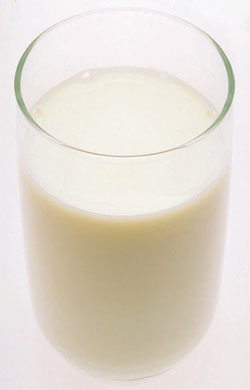Food allergy
Humans eat a large variety of foods. A small proportion of us are unable to tolerate certain kinds of food – we develop an adverse reaction if these foods are taken. This occurs because the immune system responds unfavourably to certain proteins present in these foods. We call this food allergy. It affects about 3% of the population and is more common in children, affecting 6% of children less than 3 years old. The most common food allergy in children is milk allergy. Infant milk formula is derived from cow milk. It is the presence of cow milk proteins in milk formulas ingested into the body that stimulate the immune system to react to foreign proteins. In this instance the response is not beneficial and it leads to release of chemicals or cell damage at certain tissues which account for the variety of manifestations. Other foods like egg, peanuts and shellfish are less common causes.
Food intolerance
There is another condition which should not be confused with food allergy, and that is food intolerance. Here the mechanism causing the problem is different and it does not involve the immune system.
Some are intolerant of cow milk not because of allergy, but because they lack an enzyme to digest a sugar that is naturally present in cow milk called lactose. Lactose intolerant people may get symptoms of colic, tummy pains or diarrhoea. Lactose is the problem, so if these people are given a lactose-free cow milk formula, the causal factor is removed and the problem is resolved.
Manifestations of cow milk allergy
Since milk constitutes the main diet of babies and some children, the problem of allergy becomes significant in those who react to it. Cow milk allergy manifests in a variety of forms. It is important to recognise them so that early diagnosis can be made. These manifestations include skin reactions like rashes, eczema, hives or intestinal problems like vomiting, colic, diarrhoea, blood in vomitus or stools and respiratory complaints like runny nose, cough or wheezing. All these symptoms are not specific to cow milk allergy as there are other causes of the listed problems so one must be careful not to jump too early to the conclusion that cow milk is the culprit in a child with any of these complaints.
Making the diagnosis
If a child has these symptoms for some time, then he or she will need to be evaluated by a doctor. The doctor will go through the history of the problems to identify how and when it started and how chronic or severe it has been. The child will be examined to look for tell-tale signs and clues. Other diagnoses need to be excluded. The dietary history will be important. It is easier to diagnose milk allergy in the young baby because that is about the only food the child is taking. It will be harder to pinpoint the allergic food, say in a one-year-old child, as the food consumed is more varied. Fortunately, milk allergy tends to occur early in the first few months of life, and those who are allergic tend to tolerate it as they grow older from one year onwards. Milk allergy may have either a rapid or a slow onset. Some will have symptoms very soon after taking milk, eg swelling of lips, itch, swollen eyes or even shock, whereas others will show a slow progression over several weeks or months.
Testing for allergy?
The diagnosis of cow milk allergy is mainly clinical, ie it is dependent on the doctor’s judgement after he has put all the history and physical clues into perpective. There is no specific blood test to say if this is allergy or not. If necessary, skin prick tests or blood test for specific food allergens can be done, and the results will be interpreted and evaluated accordingly to strengthen the diagnosis. An even more important and useful “test” is food elimination or challenge. Very simply, the principle involves either avoiding or giving the suspected food (cow milk) to the child. If the child is allergic to it, there will be either improvement or worsening of the symptoms, respectively.
Treatment options
Once a diagnosis is made, the only treatment is milk avoidance. Some important points need to be made. If all babies were fully breast fed, then there would be no cow milk to cause allergy. However, some susceptible babies can still have cow milk allergy even though they are on breast milk. The situation arises due to maternal ingestion of dairy products – some cow milk protein will be absorbed and pass into the mother’s milk and be taken by the baby, wherein it provokes an allergic response. The remedy in this situation is for the mother to abstain from dairy products. Changing over to goat milk formula is ill advised, as goat milk protein shares similar characteristics with cow milk and is as likely to be allergic. For those who for some reason cannot breast-feed, then a suitable alternative is to use soy protein infant formulas. These are not simple soy bean milk/drinks but are specially constituted formulas capable of meeting all the nutrient requirements of a growing child. They are constituted to give the correct balance of fats, carbohydrates, protein and vitamins and trace elements. They work well in those who are cow milk allergic because the protein source here is soy protein isolates, not cow milk protein. However, it is possible that a child who is allergic to cow milk is also allergic to soy protein. In this situation the alternative is to give very specialised formulas known such as extensively hydrolysed milk formulas. Processing has partially digested and extensively broken down the cow milk protein into smaller fragments which are then less likely to induce allergy. An even “purer” feed are the elemental formulas where the cow milk protein exists only in its simplest form as amino acids.
A happy ending?
The prognosis or outcome in children with cow milk allergy is good as a large majority of them will gradually develop tolerance to it from about 1 year old and by 5 years most would no longer be allergic. In the small minority who are still sensitive, avoiding milk, dairy products and foods that contain dairy products will provide a very satisfactory quality of life without troublesome symptoms.






Comments